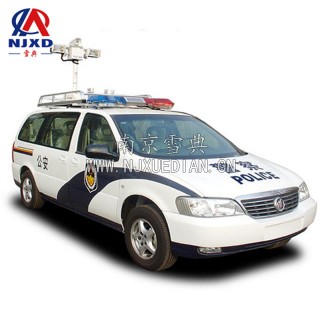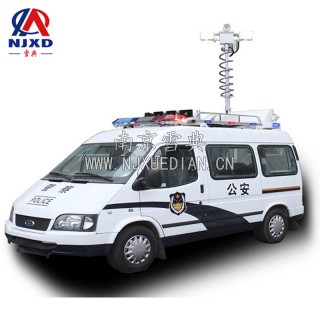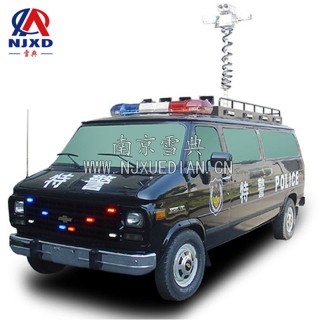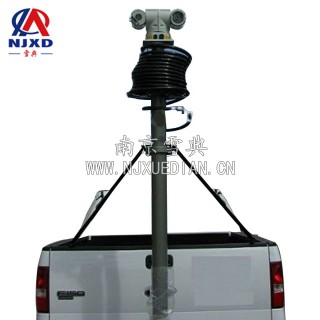NEWS
Rotation and control principle of lifting surveillance cloud platform
Time:2021-01-29 View:

rotational velocity
AC PTZ uses AC motor, rotational velocity fixed, generally horizontal rotational velocity is 4 °/second ~ 6 °/second, vertical rotational velocity is 3 °/second ~ 6 °/second. Some manufacturers also produce AC high-speed PTZ, which can reach horizontal 15 °/second and vertical 9 °/second, but the high-speed load capacity of the same series PTZ will be reduced accordingly. Most of the DC pan-tilt units use DC stepping motors, which have the advantages of high rotating speed and variable speed, and are very suitable for occasions requiring fast target capture. Its horizontal highest revolving speed can reach 40~50 °/second, and vertical can reach 10~24 °/second. In addition, the DC head has the variable speed function, and the voltage provided is the variable voltage between 0 and 36V DC. The effect of variable speed is determined by the performance of the control system and decoder, so that cloud deck motor can rotate at the corresponding speed according to the input voltage. There are two common variable speed control methods. One is full variable speed control, which determines the input voltage to the pan head by detecting the displacement of the operator to control the keyboard joystick, full speed control is to realize smooth speed transition within the speed range of PTZ. The other is the step-by-step control, which is to set several gears within the speed range of the PTZ. Each gear corresponds to different voltage (rotational velocity). Before operation, you must first select the speed gear to be rotated, rotate the head in all directions.

Rotation angle
The rotation angle of the pan-tilt, especially the vertical rotation angle, has a great relationship with the installation method of the load (shield/Camera/lens assembly). Generally, the horizontal rotation angle of the pan-tilt can reach 355 °, because the limit Bolt will occupy a certain angle, but there will be a little monitoring dead angle. The current PTZ has improved the limiting device so that it can reach 360 ° or even 365 ° (with a coverage angle of 5 °) to eliminate the monitoring dead angle. Users can set the limit according to the actual situation on site when using it. For example, the Wall Mounted type installed on the wall, even if the PTZ has a 360 ° rotation angle, actually only needs to monitor the 180 ° angle on the front of the PTZ, even if it turns to 180 ° in the rear direction, it can only see the installation surface (Wall), which has no practical monitoring significance. Therefore, the wall-mounted type only needs to monitor the range of 180 ° and the angle-mounted type only needs to monitor the range of 270 °. This prevents the pan-tilt from rotating too much to a position without monitoring, and also provides the use efficiency of the pan-tilt. The vertical rotation angle of the top-mounted head is generally +30 ° to-90 °, and the vertical rotation angle of the side-mounted head can reach ± 180 °, however, the vertical rotation angle can be from +20 ° to-90 ° during normal use.

Control Principle
So how to control the pan-tilt to rotate horizontally or vertically? This needs to be achieved through the PTZ control system. The PTZ control system generally consists of a console, a remote communication module, and a PTZ control module.
The console is used for the user to input control commands to the PTZ, such as moving in the upper, lower, left, and right directions. A common console can be a PC with the corresponding software system installed.
Remote communication module is used to communicate between the cloud console and the console. On the one hand, the commands sent by the console are transmitted to the cloud console; On the other hand, the data of the cloud console is fed back to the console.
Pan-Tilt controller is the core module, which is usually installed on the pan-tilt and needs to realize two main functions: Decoding the received console instructions and converting them into control signals that control the operation of the motor; according to the control signal, drive the motor on the pan head to perform corresponding actions.

CATEGORY
NEWS
- Type and internal structure of lifting surveillance cloud platform
- Rotation and control principle of lifting surveillance cloud platform
- Load capacity and environmental indicators of up to surveillance cloud platform
- Fault handling method of lifting surveillance cloud platform
- Selection and installation of lifting professional electrical platform